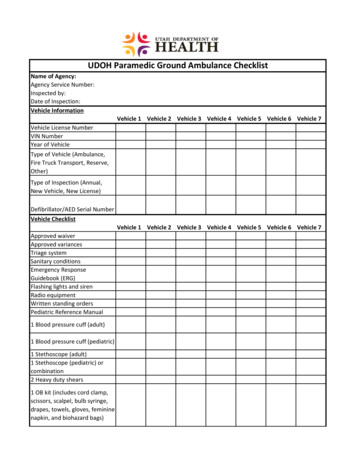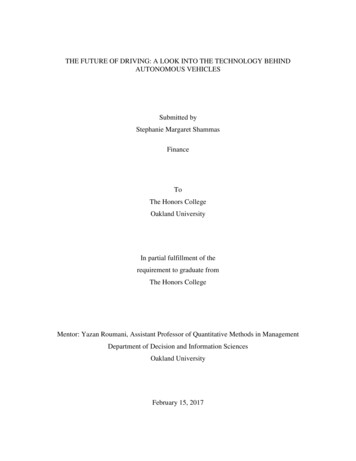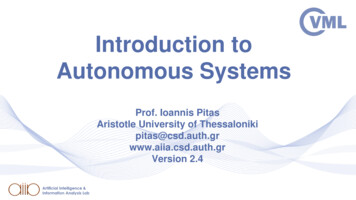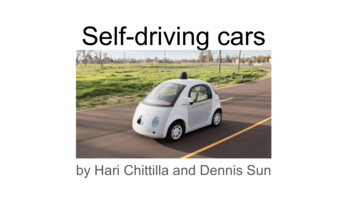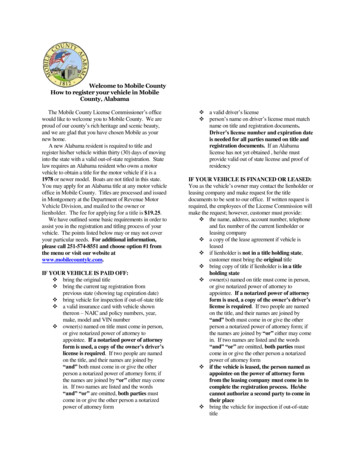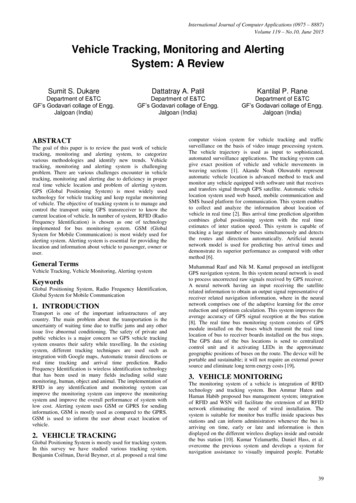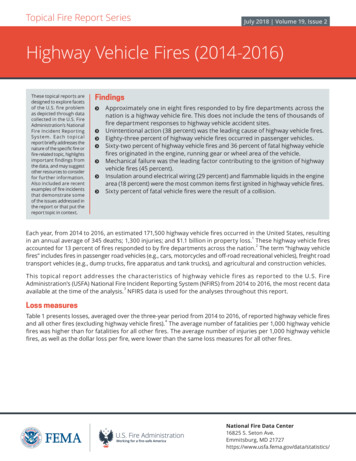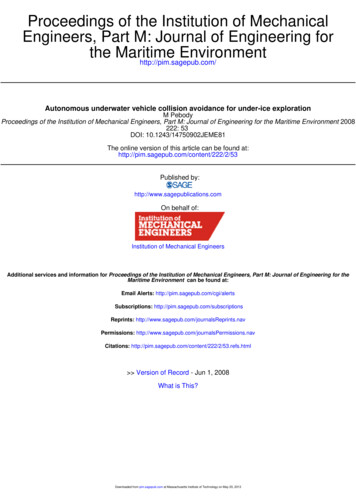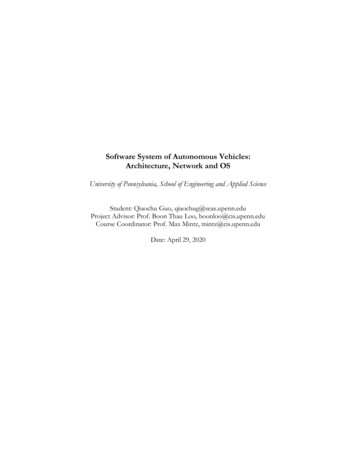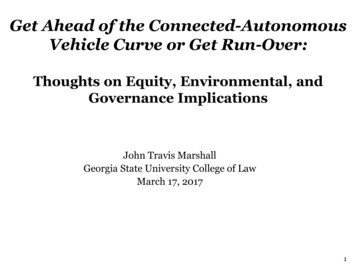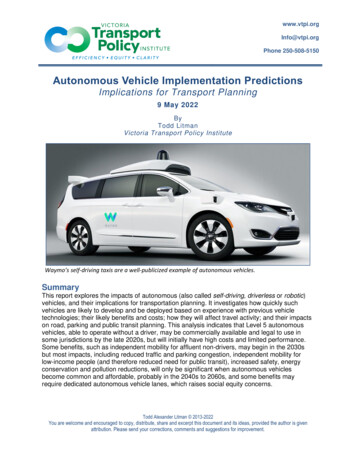
Transcription
www.vtpi.orgInfo@vtpi.orgPhone 250-508-5150Autonomous Vehicle Implementation PredictionsImplications for Transport Planning9 May 2022ByTodd LitmanVictoria Transport Policy InstituteWaymo’s self-driving taxis are a well-publicized example of autonomous vehicles.SummaryThis report explores the impacts of autonomous (also called self-driving, driverless or robotic)vehicles, and their implications for transportation planning. It investigates how quickly suchvehicles are likely to develop and be deployed based on experience with previous vehicletechnologies; their likely benefits and costs; how they will affect travel activity; and their impactson road, parking and public transit planning. This analysis indicates that Level 5 autonomousvehicles, able to operate without a driver, may be commercially available and legal to use insome jurisdictions by the late 2020s, but will initially have high costs and limited performance.Some benefits, such as independent mobility for affluent non-drivers, may begin in the 2030sbut most impacts, including reduced traffic and parking congestion, independent mobility forlow-income people (and therefore reduced need for public transit), increased safety, energyconservation and pollution reductions, will only be significant when autonomous vehiclesbecome common and affordable, probably in the 2040s to 2060s, and some benefits mayrequire dedicated autonomous vehicle lanes, which raises social equity concerns.Todd Alexander Litman 2013-2022You are welcome and encouraged to copy, distribute, share and excerpt this document and its ideas, provided the author is givenattribution. Please send your corrections, comments and suggestions for improvement.
Autonomous Vehicle Implementation Predictions: Implications for Transport PlanningVictoria Transport Policy InstituteTable of ContentsExecutive Summary. 3Introduction . 7Autonomous Vehicle Operational Models . 8Benefits and Costs. 9Reduced Driver Stress, Improved Productivity and Mobility . 9Ownership and Operating Costs . 10Traffic Safety and Security . 13External Cost . 15Social Equity Impacts . 16Benefit and Cost Summary . 18Travel Impacts . 20Development and Deployment Predictions . 25Experience with Previous Vehicle Technology Deployment . 28Deployment Predictions . 29Planning Implications . 32Roadway Design. 32Transportation Pricing . 32Curb Management . 32Parking Planning . 32Public Transit Needs . 33Other Trends Affecting Travel Demands . 33Potential Conflicts and Solutions . 37Conclusions . 38References . 41Driving in mixedtraffic involvesnumerousinteractions withdiverse pedestrians,animals, bicyclistsand vehicles, and sois more complexthan flying anairplane. (KeithShaw)2
Autonomous Vehicle Implementation Predictions: Implications for Transport PlanningVictoria Transport Policy InstituteExecutive SummaryMany decision-makers and practitioners wonder how autonomous (also called self-driving orrobotic) vehicles (AVs) will affect future travel, and therefore the need for roads, parkingfacilities and public transit services, and what public policies can minimize the problems andmaximize the benefits of these new technologies. This report explores these issues.Optimists predict that by 2030, autonomous vehicles will be sufficiently reliable, affordable andcommon to displace most human driving, providing huge savings and benefits. However, thereare good reasons to be skeptical. Most optimistic predictions are made by people with financialinterests in the industry, based on experience with disruptive technologies such as digitalcameras, smart phones and personal computers. They tend to ignore significant obstacles toautonomous vehicle development, and exaggerate future benefits.There is considerable uncertainty concerning autonomous vehicle development, benefits andcosts, travel impacts, and consumer demand. Considerable progress is needed beforeautonomous vehicles can operate reliably in mixed urban traffic, heavy rain and snow, unpavedand unmapped roads, and where wireless access is unreliable. Years of testing and regulatoryapproval will be required before they are commercially available in most jurisdictions. The firstcommercially available autonomous vehicles are likely to be expensive and limited inperformance. They will introduce new costs and risks. These constraints will limit sales. Manymotorists will be reluctant to pay thousands of extra dollars for vehicles that will sometimes beunable to reach a destination due to inclement weather or unmapped roads.Exhibit ES-1 illustrates autonomous vehicle user costs. They are likely to be more expensivethan human-driven private vehicles and public transit, but cheaper than ridehailing and humandriven taxis. Shared autonomous vehicles will be cheaper but less convenient and comfortablethan private AVs, so many households, particularly in suburbs and rural areas, will own AVs.Exhibit ES-1Cost Comparison 2.50Autonomous Vehicles (AV)Human Driven (HD)Dollars Per Mile 2.00 1.50 1.00 0.50 0.00HO carvariablecostsShared AVPublictransitAV variablecostsHD xiAutonomous vehicles (AVs) are likely to cost more than human-operated (HO) private vehicles and publictransit, but less than human-driven taxis and ridehailing services.3
Autonomous Vehicle Implementation Predictions: Implications for Transport PlanningVictoria Transport Policy InstituteAutonomous vehicles will have various benefits and costs, including many external costs (costsimposed on other people). All of these impacts should be considered when planning for AVs.External (Impacts on others)Internal (user Impacts)Exhibit ES-2Autonomous Vehicle Potential Benefits and CostsBenefitsCosts/ProblemsReduced drivers’ stress and increasedproductivity. Motorists can rest, play and workwhile travelling.Increased vehicle costs. Requires additional vehicleequipment, services and fees.Additional user risks. Additional crashes caused by systemfailures, platooning, higher traffic speeds, additional risktaking, and increased total vehicle travel.Mobility for non-drivers. More independentmobility for non-drivers can reduce motorists’chauffeuring burdens and transit subsidy needs.Reduced security and privacy. May be vulnerable toinformation abuse (hacking), and features such as locationtracking and data sharing may reduce privacy.Reduced paid driver costs. Reduces costs for taxisservices and commercial transport drivers.Increased infrastructure costs. May require higher roadwaydesign and maintenance standards.Increased safety. May reduce crash risks andinsurance costs. May reduce high-risk driving.Additional risks. May increase risks to other road users andmay be used for criminal activities.Increased road capacity and cost savings. Moreefficient vehicle traffic may reduce congestionand roadway costs.Increased traffic problems. Increased vehicle travel mayincrease congestion, pollution and sprawl-related costs.Reduced parking costs. Reduces demand forparking at destinations.Social equity concerns. May reduce affordable mobilityoptions including walking, bicycling and transit services.Reduced energy consumption and pollution. Mayincrease fuel efficiency and reduce emissions.Reduced employment. Jobs for drivers may decline.Supports vehicle sharing. Could facilitatecarsharing and ridesharing, reducing total vehicleownership and travel, and associated costs.Reduced support for other solutions. Optimistic predictionsof autonomous driving may discourage other transportimprovements and management strategies.Autonomous vehicles can provide various benefits and costs, including external impacts on other people.Vehicles last longer, cost more, impose larger external costs, and are more highly regulatedthan most other consumer goods. As a result, vehicle technologies take longer to penetratemarkets than most other sectors. It will probably take decades for autonomous vehicles todominate new vehicle purchases and fleets, and some motorists may resist using them.Optimistically, autonomous vehicles will be safe and reliable by 2025, and may be commerciallyavailable in many areas by 2030. If they follow the pattern of previous vehicle technologies,during the 2030s and probably the 2040s, they will be expensive and limited in performance,sometimes unable to reach a desired destination or requiring human intervention when theyencounter unexpected situations. Customers will include affluent high-annual-mileagemotorists and businesses. For the foreseeable future most moderate- and low-incomehouseholds will continue to use human-operated vehicles.4
Autonomous Vehicle Implementation Predictions: Implications for Transport PlanningVictoria Transport Policy InstituteShared autonomous vehicles (self-driving taxis) and rides (micro-transit services) may be widelyavailable by the 2030s. Shared vehicles have moderate operating costs, and offer moderateconvenience and comfort. They should be cheaper than current taxi and ridehailing services,but offer lower quality service since no driver will be available to assist passengers, providesecurity, or clean vehicles. Vehicle dispatching will sometimes be slow and unpredictable,particularly in suburban and rural areas. Shared rides will have the lowest costs but the leastconvenience and comfort. Because of their high labor costs and predictable routes, long-haulbuses and freight trucks are particularly appropriate for autonomous operation, so self-drivingbuses and trucks may become common in the 2030s and 2040s.The figure below illustrates these market penetration and benefits projections. This indicatesthat it will probably be 2045 before half of new vehicles are autonomous, 2060 before half ofthe vehicle fleet is autonomous, and possibly longer due to technical challenges or consumerpreferences. Level 4 autonomy (able to operate autonomously under limited conditions, suchas on grade-separated highways) can reduce driver stress and increase productivity, but mostbenefits require Level 5 autonomy (able to operate autonomously under all normal conditions)so vehicles can transport non-drivers and travel empty to pick up or drop off passengers.Exhibit ES-2Autonomous Vehicle Sales, Fleet, Travel and Benefit ProjectionsThis analysis suggests that it will be at least 2045 before half of new vehicles are autonomous, and 2060before half of the vehicle fleet is autonomous. Significantly faster deployment will require scrapping manyotherwise functional vehicles that lack self-driving ability. Some benefits, such as reduced driver stress andindependent mobility for affluent non-drivers, can occur when autonomous vehicles are relatively costlyand rare. However, most benefits, such as independent mobility for moderate-income non-drivers andaffordable taxi and micro-transit services, can only be significant if they become common and affordable,and some benefits, such as reduced congestion, will require dedicated lanes to allow platooning.5
Autonomous Vehicle Implementation Predictions: Implications for Transport PlanningVictoria Transport Policy InstituteMany predictions assume that most autonomous vehicles will be electric, which have low fuelcosts but require costly batteries and currently pay no fuel taxes. Incorporating batteryreplacement costs and efficient road user fees increases electric vehicle operating costs to besimilar to fossil fuel vehicles.An important planning issue is whether autonomous vehicles will increase or reduce totalvehicle travel and associated traffic problems. It could go either way. By increasing non-drivers’vehicle travel, increasing travel convenience and comfort, reducing vehicle operating costs,generating empty travel, and encouraging longer-distance commutes and more sprawleddevelopment, they can increase vehicle travel. This additional vehicle travel provides marginalconsumer benefits, and since vehicle travel imposes significant external costs, much of theadditional vehicle travel is likely to be economically inefficient: its user benefits will be less thantotal incremental costs. Alternatively, autonomous operation may facilitate vehicle sharing,allowing households to reduce vehicle ownership and vehicle travel. This suggests that AVs willincrease vehicle travel in suburban and rural areas, and reduce it in urban areas. Their netimpacts will depend on transport and land use development policies. With current policies,vehicle travel and sprawl are likely to increase 10-30%. More efficient pricing, and roadwaymanagement which favors shared vehicles, can reduce vehicle travel and associated problems.Another critical issue is the degree that potential benefits can be achieved when only a portionof vehicle travel is autonomous. Some benefits, such as improved mobility for affluent nondrivers, may occur when autonomous vehicles are uncommon and costly, but many potentialbenefits, such as reduced congestion and emission rates, reduced traffic signals and lanewidths, require that vehicles operate autonomously in dedicated lanes.Autonomous vehicle implementation is just one of many trends likely to affect future transportdemands and impacts, and not necessarily the most important. Their ultimate impacts dependon how autonomous vehicles interact with other trends, such as shifts from private to sharedvehicles. Autonomous vehicles will probably not be a “game changer” during most of our lives,and will only cause a “paradigm shift” if this technology causes large shifts from private toshared vehicles and creates more multi-modal communities.Transportation professionals have important roles to play in autonomous vehicle developmentand deployment. We must anticipate how new technologies and services are likely to affectroad, parking and public transit needs, and how to respond to minimize problems and maximizetotal benefits. We can help define the standards they must meet to legally operate on publicroads. We should evaluate their benefits and costs and develop policies to maximize netbenefits and ensure that their deployment supports strategic community goals.6
Autonomous Vehicle Implementation Predictions: Implications for Transport PlanningVictoria Transport Policy InstituteIntroductionThe future is ultimately unknowable but planning requires predicting impending conditions andneeds. Many decision-makers and practitioners (planners, engineers and analysts) wonder howautonomous (also called self-driving or robotic) vehicles will affect future travel demands, andtherefore the need for roads, parking facilities and public transit services, and what publicpolicies can minimize their risks and maximize their benefits (APA 2016; Berrada and Leurent2017; Grush and Niles 2018; Guerra 2015; Kockelman and Boyles 2018; Larco 2022; Milakis, vanArem and van Wee 2017; Shaheen, Totte and Stocker 2018; Sperling 2017).There is considerable uncertainty about these issues. Optimists predict, based on experiencewith previous technological innovations such as digital cameras, smart phones and personalcomputers, that autonomous vehicles will soon be sufficiently reliable and affordable to replacemost human driving, providing huge savings and benefits (Johnston and Walker 2017; Keeney2017; Kok, et al. 2017). However, there are good reasons to be skeptical of such claims.Optimistic predictions often overlook significant obstacles and costs. Many technical problemsmust be solved before autonomous vehicles can operate reliably in all normal conditions(Knight 2020; Leonard, Mindell and Stayton 2020; Norton 2021). They will require years oftesting and regulatory approval to progress on what technologists call the TechnologyReadiness Level (TRL) scale, from an idea to full commercial availability (McLeod 2021), andover time become affordable and attractive to consumers. Motor vehicles are costly, durable,and highly regulated, so new vehicle technologies generally require decades to penetrate fleets.Autonomous driving can create new problems; a camera, telephone or computer failure may befrustrating but is seldom fatal; motor vehicle system failures can be frustrating and deadly tooccupants and other road users. As a result, autonomous vehicles will probably take longer todevelop and provide smaller net benefits than optimists predict.This has important policy implications (Papa and Ferreira 2018; Speck 2017). Vehicles rely onpublic infrastructure and can impose large external costs, and so require more planning andregulation than most other technologies. For example, many predicted autonomous vehiclebenefits, including congestion and pollution reductions, require dedicated lanes to allowplatooning (numerous vehicles driving close together at relatively high speeds), andautonomous vehicles can be programed to prioritize user benefits such as maximizing travelspeed and occupant comfort, or community benefits such as minimizing delay and risks to otherroad users. Policy makers must decide whether to build special autonomous vehicle lanes, howto price them, and how to regulate their operation in maximize total benefits (Zipper 2021).This report explores these issues. It investigates, based on experience with previous vehicletechnologies, how quickly self-driving vehicles are likely to be developed and deployed,critically evaluates their benefits and costs, and discusses their likely travel impacts and theirimplications for planning decisions such as optimal road, parking and public transit supply.7
Autonomous Vehicle Implementation Predictions: Implications for Transport PlanningVictoria Transport Policy InstituteAutonomous Vehicle Operational ModelsExhibit 1 describes the five levels of autonomous driving. Level 4 offers autonomous mobilityunder some conditions and Level 5 offers autonomous mobility under all normal conditions.Exhibit 1Automated Driving Levels (SAE J3016 2014)The Society of Automotive Engineers (SAE) defines five vehicle automation levels. Most predicted benefitsrequire level 5, which allows vehicles to transport non-drivers and goods, and travel empty.Exhibit 2 compares four vehicle operating models.Exhibit 2Operating Models ComparedPrivate HumanPrivate AutonomousDriven VehiclesVehiclesShared AutonomousVehiclesSharedAutonomous RidesMotorists own or lease,and drive, a vehicle.Households own or leaseself-driving vehicles.Self-driving taxis offerserve individuals.Micro-transit servesmultiple passengers.Low costs. Alwaysavailable. Users canleave gear in vehicles.Pride of ownership.High convenience.Always available. Userscan leave gear invehicles. Pride ofownership.Users can choose vehiclesthat best meet theirneeds. Door to doorservice.Lowest total costs.Minimizescongestion, risk andpollution emissions.DisadvantagesRequires driving ability,and associated stress.High costs. Users cannotchoose different vehiclesfor different uses. Likelyto increase vehicle traveland associated costs.Users must wait forvehicles. Limited services(no driver to helppassengers carry luggageor ensure safety.Least speed,convenience andcomfort, particularlyin sprawled areas.AppropriateusersLower- and moderateincome suburban andrural residents.Affluent suburban andrural residents.Lower-annual-mileageusers.Lower-income urbanresidents.AdvantagesAutonomous vehicles can be private or shared. Each model has advantages and disadvantages.8
Autonomous Vehicle Implementation Predictions: Implications for Transport PlanningVictoria Transport Policy InstituteBenefits and CostsThis section describes autonomous vehicle benefits and costs.Reduced Driver Stress, Improved Productivity and MobilityAutonomous vehicles can reduce drivers’ stress and tedium, and increase their productivity.They can be mobile offices and bedrooms, as illustrated below, allowing passengers to rest orwork while travelling (WSJ 2017). This reduces travel time unit costs (cost per hour). However,for safety sake occupants should wear seatbelts, restricting use of in-vehicle beds, and like anyconfined space, vehicle interiors are likely to become cluttered and dirty (Broussard 2018).Exhibit 3Productivity and Relaxation While TravellingAutonomous vehicles can be mobile offices and bedrooms, allowing travelers to work and rest.Self-driving vehicles can introduce new stresses and discomforts. Travelers may experience“access anxiety” if vehicles are sometimes unable to reach desired destinations, for example,due to heavy rain or snow, or if an area lacks the detailed maps required for autonomousoperation (Grush 2016). Self-driving taxi and micro-transit services will be cheaper than humanoperated taxis but offer lower service quality since there will be no drivers to help carrypackages or ensure passenger safety. To minimize cleaning and vandalism costs most surfaceswill be stainless steel and plastic, and security cameras will monitor passengers, yet they maystill encounter previous occupants’ garbage, stains and odors (Broussard 2018). Sharedautonomous rides (micro-transit) require passengers to share space with strangers, and eachadditional pick-up or drop-off can impose delays, reducing speeds and reliability.Autonomous vehicles can provide independent mobility for people who for any reason cannotor should not drive. This directly benefits those travelers, and by improving their access toeducation and employment opportunities, can increase their productivity, and reducechauffeuring burdens on their family members and friends. On the other hand, optimisticpredictions of autonomous vehicle benefits may cause some communities to reduce supportfor public transit services which may reduce mobility options for non-drivers (Creger, Espinoand Sanchez 2019). Dedicating highway lanes for autonomous vehicle platooning may reducecapacity for human-operated traffic, harming human-operated vehicle occupants.9
Autonomous Vehicle Implementation Predictions: Implications for Transport PlanningVictoria Transport Policy InstituteOwnership and Operating CostsAutonomous vehicles require various equipment and services summarized in the box below.Since failures could be deadly, autonomous vehicles will need robust and redundantcomponents, installed and maintained by specialists, increasing maintenance costs. Currentadvanced driver assistance system sensors (cameras, radar and ultrasound) approximatelydouble minor collision damage costs, typically adding 3,000 to a repair bill (AAA 2018),suggesting that autonomous vehicles will increase vehicle repair costs. Vehicle owners willprobably need to subscribe to frequent software update and navigation mapping services.Currently, a set of optional vehicle accessories, such as remote starting, adaptive cruise control,active lane assist and safety cameras, typically cost several thousand dollars, and subscriptionsto navigation and security services, such as OnStar and TomTom, cost 150-750 annually.Exhibit 4Autonomous Vehicle Equipment and Service RequirementsAll Autonomous VehiclesShared Autonomous Vehicles Sensors (optical, infrared, radar, laser, etc.). Automated controls (steering, braking, signals, etc.) Software, servers and power supplies. Short range vehicle-to-vehicle communicationnetworks, plus Internet access for maps, softwareupgrades and road reports. Software and navigation map update subscriptions. Critical component maintenance, repair and testing. Dispatching and fleet management. Business administration and insurance. Business profits. Security. Frequent cleaning and repairs. Delays and empty vehicle-miles for passengerloading.Autonomous vehicles, particularly those that are shared, will incur additional costs.Some experts predict that electric autonomous vehicle will costs less than 5 per mile tooperate (ignoring all fixed costs), but this is probably an underestimate. Vehicle batteries mustbe replaced approximately every 100,000 miles, which currently costs 3,000-15,000, or 3-10 per vehicle-mile. This may decline with production innovations, but probably not much sincefuture vehicles will require increasingly sophisticated batteries to maximize performance.Electric vehicles currently pay no fuel taxes; cost-recovery road-user fees would add 5-10 pervehicle-mile. Incorporating these factors increases electric vehicle operating costs to 10-25 permile, similar to fossil fuel vehicles.What are Efficient Road User Fees?Efficient road user fees recover roadway costs, with additional charges for congestion, crash andpollution damages imposed on others. Government roadway expenditures total about 250 billionannually which serves about 3,200 billion vehicle-miles, which averages about 8 per mile (FHWA 2016);optimal fees are somewhat lower fees for automobiles and higher for heavy vehicles which imposegreater roadway costs. Under urban-peak conditions, decongested fees of 5-25 per mile are typicallyrequired to reduce traffic volumes to roadway capacity. In addition, any electric vehicle emission feesshould be distance-based so drivers pay according to the amount they drive and the costs they impose.10
Autonomous Vehicle Implementation Predictions: Implications for Transport PlanningVictoria Transport Policy InstituteExperience with previous vehicle innovations, such as automatic transmissions and airbags,suggests that autonomous driving capability will initially be available only on higher pricedmodels and will probably take decades to become standard on lower-priced models.Some advocates argue that insurance and fuel savings will offset these costs (Intellias 2018) butthat seems unlikely. For example, if autonomous driving reduces collision insurance costs byhalf, the 300-500 annual savings is just 10-20% of estimated additional costs. Fuel cost savingsare also likely to be small or negative due to additional equipment, larger vehicles to serve asmobile offices, and induced vehicle travel.As a result autonomous driving capability will probably add several thousand dollars to newvehicle purchase prices, plus hundreds of dollars in additional annual maintenance, repair,software and mapping subscription costs. This will add a few thousand dollars in annualizedexpenses, at least for the first few decades of their commercial availability, until competitionand depreciation make these technologies available on cheaper models and used vehicles. Thissuggests that for the foreseeable future private autonomous vehicle costs will probably average 0.80- 1.20 per vehicle-mile, which may eventually decline to 0.60- 1.00 per mile as thetechnology becomes available in cheaper models. Shared autonomous vehicles (self-drivingtaxis) will probably cost 0.50 to 1.00 per vehicle-mile, and shared autonomous rides willprobably cost 0.20-0.40 per passenger-mile (Nunes and Hernandez 2020). This is cheaper thanhuman-operated taxis ( 1.50 to 3.00 per mile), but more expensive than personal vehicleoperating costs or public transit fares (20-40 per passenger-mile).Some studies estimate lower costs. For example, Kok, et al. (2017) predict that shared, electricautonomous vehicles will cost less than 10 per mile, cheap enough that many trips could befunded through advertising, but such estimates ignore costs such as cleaning and vandalismrepairs, profits, empty vehicle travel, insurance (many assume 90% lower insurance premiums),and road
Autonomous Vehicle Implementation Predictions: Implications for Transport Planning Victoria Transport Policy Institute 3 Executive Summary Many decision-makers and practitioners wonder how autonomous (also called self-driving or robotic) vehicles (AVs) will affect future travel, and therefore the need for roads, parking facilities and public transit services, and what public policies can .

